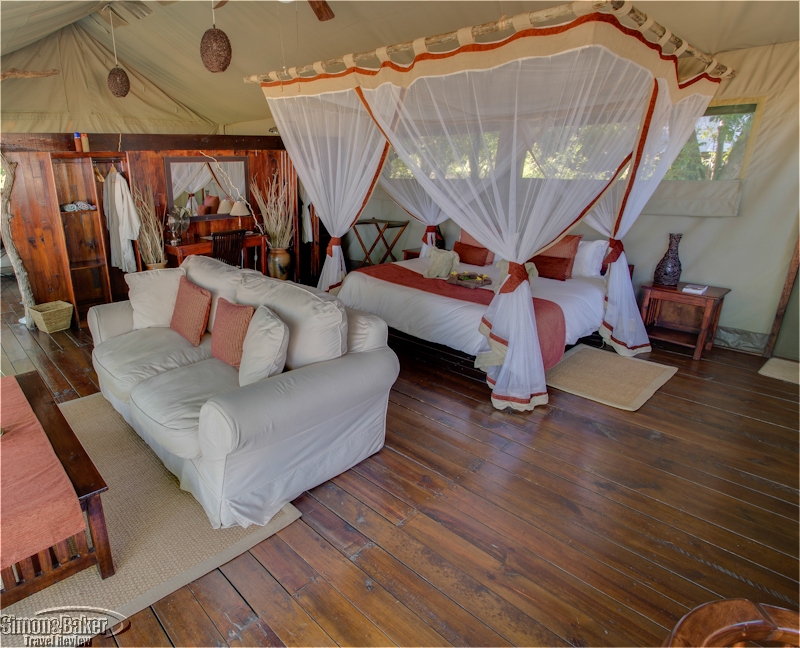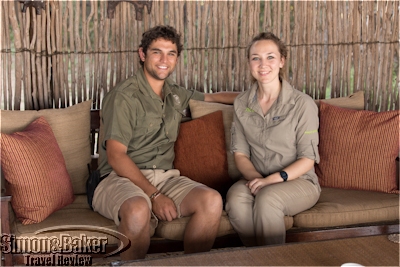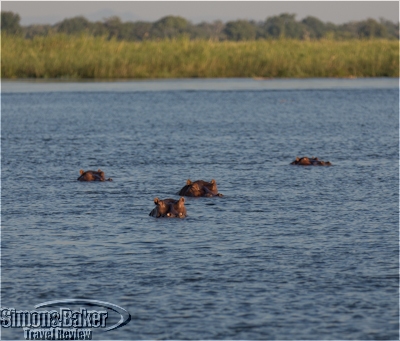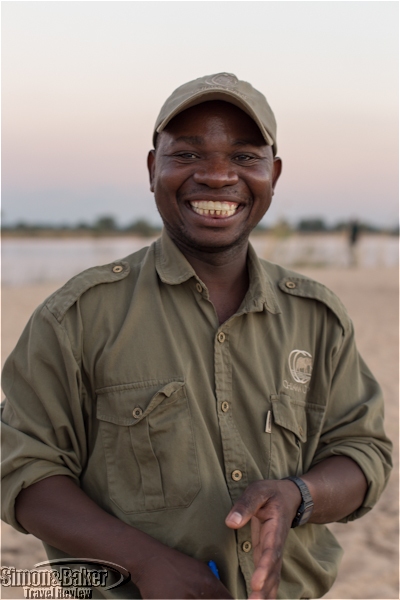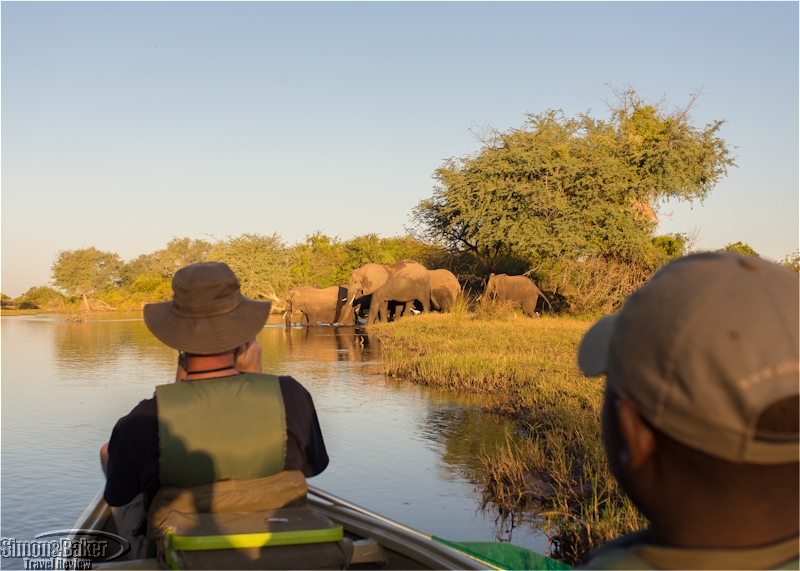
The camp had nine luxury tents that could accommodate up to 16 guests, each raised on wooden decks with river views. We stayed in Deluxe Tent Seven, complete with king-sized bed and all the fittings we might expect of a high end safari lodge. We especially liked taking hot bubble baths in the elegant claw and cloth bathtub that warmed us up on cool Zambian winter evenings. The service was superb, from the nightly hot water bottles to a private three-course lunch served on our veranda, and the food throughout was consistently good. One of the most memorable meals we’ve ever had was a candlelit barbeque dinner under a full moon on a small sand bar in the middle of the Zambezi River.
Not ten minutes after our arrival, we were hustled into a private open-top Toyota Land cruiser and sped off into the moonlit night to look for a lioness that we could hear roaring from the camp lobby. Along the way we had an exhilarating encounter with an elephant. Game viewing was not foregone on days we chose to relax in our high-end tent. From our private patio we could watch warthogs, impalas and baboons meander down a dry riverbed towards the Zambezi River.
One of the most memorable aspects of our stay was the ever present, slow moving and vast Zambezi River. It added serenity to our experience, placing us in touch with some of the natural rhythms of the beautiful Lower Zambezi National Park. It was a delight to sit quietly at breakfast, sipping coffee, and watch the river glide by.
The camp also had a vibrant history. While there we met co-owner Grant Cumings. Over dinner he shared riveting stories about battles with poachers in the early days of the property. Chiawa’s legacy of conservation added to the atmosphere of the place, and the staff’s commitment to responsible tourism made us even bigger fans of the property.
Chiawa had everything we could ask for including stunning natural beauty, authentic conservation credentials, excellent game viewing with accomplished guides, grand tented accommodations and exemplary service. For an authentic safari experience with class and social consciousness, we would return in a heartbeat.
Class Of Accommodation Superior luxury safari tents
Connectivity Although our tent had Wi-Fi the owners requested that we keep usage to reasonable levels as the same connection was also used for day-to-day operations.
General Manager Joshua Chizuwa
Handicapped Access There was no handicapped access due to the dangers associated with wildlife and the remote location of the camp.
Length Of Stay 3 nights
Location Chiawa is located on the bank of the Zambezi River within the Lower Zambezi National Park. We flew by small plane from Lusaka to Royal (35 minutes), followed by a short overland drive (20 minutes) to a boat, which took us to the camp (20 minutes).
Managed Dave and Jenny Cumings ran operations from Lusaka, while Grant and Lynsey Cumings were based at Chiawa and Lusaka.
Owned The Cumings family.
Pets No pets were allowed.
Size The camp had nine luxury tents that could accommodate up to 16 guests. The camp covered two acres (48,000 square meters), within the 75 mile (120 kilometers) river frontage of the Lower Zambezi National Park. There were 45 staff members at the camp, including six guides and trackers.
Year Opened And Date Of Most Recent Renovation Founded in 1989, Chiawa’s most recent major renovations took place in 2008 when the staff completely rebuilt six tents from the ground up. We stayed in Tent Seven, the next tent up for renovations. Each year the Camp fine-tuned and tweaked its infrastructure, according to management representatives.
Several feet away another open wooden structure with thatched roof housed the dining area. In it were long wooden tables that could accommodate up to ten guests each. At nighttime the tables were lit by candlelight. The overall effect was charming and romantic. Near the dining area, towards the river, there was an open fire pit surrounded by a circle of wooden and canvas field chairs. We typically ate our breakfast there, looking out onto the Zambezi as it glided past.
In between the bar and dining areas there were two public restrooms in a thatch roof structure with thick linen curtains attractively draped over the doorways. The public sink area had hand soap and linen napkins.
Room We stayed in Deluxe Tent Seven, which was elevated on a wooden deck made of commercially harvested pine. It was approximately 23 feet (7 meters) by 36 feet (11 meters) in size. A grass-thatched roof protected the tent from the afternoon sun. The canvas tent faced southwest, offering excellent views out onto the dried Chowe riverbed running into the Zambezi River. The tent was open-fronted (covered by a thick mosquito net), so we could easily watch game such as baboons, waterbuck and warthogs come down to the water’s edge to drink. The décor was classic safari with dark mahogany furniture. The comfortable king-sized bed was covered in Egyptian linen white bed sheets and protected by mosquito netting. A ceiling fan and light were above the bed while small wooden nightstands with reading lamps were on either side of it. In one corner of the room there was a wooden desk and chair and standing fan, and in the middle of the sitting area there was a comfortable overstuffed off-white upholstered love seat with rust-colored throw pillows. A dark wooden coffee table was on top of a neutral colored throw rug. Along the wooden partition that separated the sleeping area from the bathroom there was a large mirror in a mahogany frame above a wooden table. Next to it was a tall wooden shelf unit that provided plenty of room to store personal items. Large pottery containers filled with tall feathery dried-out reeds added a finished look to the décor.
We had a delightful lunch one day on the veranda. A wooden sofa with cushions and a wooden table provided a spot to watch wildlife meander down to the river.
Breakfasts were served buffet style by the fire pit, close to the river. There was a wide choice of cereals, toast, muffins, porridge, fruit and yoghurt, with the option of eggs cooked to choice over the open fire. The serene backdrop of the Zambezi River made breakfast extra special.
Dinners were fresh and tasty four-course meals (with exception of an outstanding barbeque on the final night). Dinner on the first night was preceded by a performance of the male staff members singing traditional African songs. We were escorted to a candlelit table on the open deck of the dining area, and the meal started with a caramelized onion tarte, followed by butternut squash soup, tilapia with lemon and butter with potato croquettes and sautéed veggies, and complete with a caramelized salted cake. South African red and white wines were offered throughout the meal, along with coffee and tea for dessert.
Though the food in and of itself was outstanding, equally impressive were the varied places where meals were served. On the second day, we had lunch on a boat floating in the river, and at our request, on the veranda outside our tent on the third day. On the boat, we had rice, pepper and cheese salad, accompanied by rosemary bread (the property freshly baked breads were notable), stuffed chicken breast and roast potato, followed by a cheese and fruit selection for dessert. We were also offered sparkling wine, but declined because we did not want to be sleepy during the afternoon canoe trip. In the late afternoon, treats such as brie with jam or cakes were served with tea and coffee.
On our last night we had one of the most memorable dining experiences of our lives. Dinner was served under a full super moon on a sandbank in the Zambezi River. Unbeknownst to us, the staff had spent a good part of the afternoon setting up family style dining tables with tablecloths, glassware, stemware, candles and a full bar. They even brought over a fully functional toilet, curtained off for privacy. The scenery was absolutely stunning as we watched the sunset while sipping pre dinner drinks. It was the perfect spot to watch the super moon slowly ascend into the sky. The food was cooked on the sandbar over an open fire. On offer was a barbeque selection of chicken, beef and pork with a variety of salads. Also available were a range of traditional Zambian foods such as Nshima (the main cornmeal staple of the country), creamed spinach with peanut sauce, and elephant bread (a bread made with beer). We had no room for dessert.
We had no need to cool down because we visited in winter. The staff informed us that in the summer months guests could wear special wet towels to bed with the fans on instead of air conditioning associated with high power consumption.
Facilities A gift shop and in the main common area, there was also a small library (about 45 books donated by guests through a book exchange).
Gift Shop Chiawa had a small gift shop of local crafts and jewelry, opened on request. I bought several colorful necklaces handmade of recycled materials by a group of women belonging to a cooperative.
Pool A small circular outdoor plunge pool (about three meters in diameter) sat next to the bar area, surrounded by five sun loungers.
On the second day, we took a three hour canoe trip with game viewing. Being in the water allowed us to get closer to some of the animals than if we had been on land. After riding upstream by motorboat for 20 minutes, we canoed back via the Inkhalange Channel before paddling down the Zambezi River. At one point we drifted past a huge crocodile, only to watch it slip into the river. It was good incentive to keep our fingers out of the water. We felt we were in good hands as Wallace, our certified river guide, had carefully reviewed safety rules before we got into the four-person canoe with lifejackets. Each canoe had two guests and a guide. Just before sunset we watched a herd of elephants including young ones cross the river, led by a cautious matriarch. It was another unforgettable memory. We watched in awe the social interaction of those spectacular animals from about 50 feet, including baby elephants interlocking trunks with older ones.
On the third day, we hopped in an open Land Cruiser ready for a walking safari, but took a detour when we heard the sound of a roaring lion. A few minutes later we came across a beautiful male lion casually walking along a dirt path in the morning sun. During our two and a half hour walk through the bush, we saw beautiful open landscapes with Chirapila Mountain in the distance. We also saw impalas and warthogs, and “Limpy” the elephant, a well-known local to the camp who earned his nickname due to his distinctive walk. In the afternoon, we went on a boat safari, during which we took photos of two elephants crossing the river and munching on fresh grass on a small island. The light on the Zambezi River just before sunset was striking and ideal for taking wildlife photos.
During our stay we saw: lions, African elephants, African buffalos, kudus, common waterbucks, impalas, bushbucks, hippopotamuses, baboons, monkeys, bats, and warthogs.
In terms of birds, we saw: greenbacked herons, squacco herons, Goliath herons, cattle egrets, great white egrets, hammerkops, hadeda ibis, glossy ibis, cardinal woodpeckers, black-eyed bulbuls, yellow-bellied bulbuls, crested spurfowls, natal spurfowls, fish eagles, martial eagles, greater honeyguides, tropical boubou shrikes, puffback shrikes, little bee eaters, white-fronted bee eaters, brownhooded kingfishers, giant kingfishers, pied kingfishers, woodland kingfishers, trumpeter hornbills, crowned hornbills, redbilled hornbills, African pied wagtails, forktailed drongos, water thick knees, grey louries, Meve’s starlings, redbilled oxpeckers, and blue waxbills.
On our journey leaving Chiawa, we were given a tour of Conservation Lower Zambezi (CLS). Set up through a collaboration between Grant and the Danish Consulate, it was a nonprofit residential center providing a variety of conservation programs and furthering understanding of the natural environment in Zambia. In addition to wildlife preservation and environmental education, CLS also supported local development projects.
The Camp had a rich legacy of conservation and continued commitment to responsible tourism in the Lower Zambezi region of Zambia. In addition to heroic anti-poaching efforts since its inception in 1989, Grant crafted the first safari guide training manual with a code of conduct for Lower Zambezi guides to promote high quality and responsible guiding. The company developed a government recognized examination and certification program. Chiawa safari guides received annual professional development to ensure high quality guiding. The Cumings family also co-founded Conservation Lower Zambezi, a nonprofit organization with a residential center that provides a myriad of conservation and HIV/AIDS education program to Zambians.
Additional practices aimed at responsible tourism included biodegradable room amenities; hiring local staff; providing school uniforms, sporting goods and school materials for 300 AIDS orphans annually; and donating $25,000 to charities that assisted vulnerable populations, wildlife and habitats.
Date Of Last Visit June 2013
Reviewers Article by Laura Scheiber
Photos by Matthew James Harris
Service Chiawa’s customized service was excellent. At the Royal Airstrip, the staff offered us refreshments for the journey to camp. On arrival, Maddy Brown, researcher and hostess, handed us a refreshing tea. Daniel Susiku, one of several safari and river guides, asked what kind of activities we wished to partake in during our stay. On the second day, we had asked if one of our meals could be served on the terrace of our tent. The staff served us a delicious three course lunch with tablecloth, homemade fresh bread, and house wine of our choice.
Throughout our stay the serving staff was efficient, polite and cheerful. Management, especially Joshua Chizuwa and Stuart Rhoda, were attentive to our comfort and every need. The safari guides proved to be most knowledgeable about the surrounding area, and no matter how obscure our questions about the animals and birds we encountered, they answered them with ease. We appreciated the good humor and never ending smiles of Wallace Kabompa, one of the guides. In order to keep abreast in the field, the propety provided guides with annual refresher courses through a government certified program that Grant had spearheaded for guides in the Lower Zambezi.
Our room was always in pristine condition on our return from activities and there were also some nice touches that added to the overall pleasantness of our stay. On the day of arrival, our towels were placed on the bed in the shape of elephants. As part of our wake up call at the hour of our choice, the staff left tea and coffee outside our tent prior to breakfast. They placed hot water bottles in our bed on cold nights during the evening room service. If we ever had any questions or requests, the staff responded quickly through the easy to use walkie talkie system in our tent.
Would You Stay Again? Yes
Contact Information
- PO Box 30972
- Lusaka, Zambia 10101
- + (260) 1 261 588
- + (260) 1 262 683


